More than 2,000 construction laborers in Oregon and Idaho will see their compensation rise $9.25 an hour over the next three years under a new set of agreements negotiated by Oregon and Southern Idaho District Council of Laborers.
Ratified by District Council delegates, the agreements are with multiple employer groups, including Oregon-Columbia Chapter of Associated General Contractors, General and Concrete Contractors Association, Association of Construction Employers, Associated Wall and Ceiling Contractors, and masonry industry employers. Bargaining for the union side were the District Council’s business manager Jeff Gritz and assistant business manager Ben Nelson, and Laborers Local 737’s business manager Zach Culver and vice president Dagoberto Aranda.
The new collective bargaining agreements replace contracts that expired May 31 or June 30. They cover members of Local 737 in Oregon and Local 155 in Southern Idaho. The agreements are substantially similar if not identical. As individual members are dispatched by the union hiring hall to different kinds of jobs, they can themselves work under the terms of two or more contracts, even when employed by the same company, depending on the scope of work. Laborers are the brawn of construction, helping other construction crafts and playing a big role in road and concrete work.
The first raises — $3.50 an hour — took effect June 1.
“We’ve never got raises like this that I ever remember, in my career of 33 years,” Gritz told the Labor Press.
The raise brings journeyman wages to $28.01 to $45.91 an hour. Pay rates fall into five occupational groups and vary among six geographic zones, depending on how remote the job site. The contracts set minimums, and employers often pay above scale. Apprentices start at $24.64 to $29.64 an hour and get pay raises in increments as they gain experience on the way to becoming journeymen.
Some job classifications saw larger immediate increases than the $3.50, and the biggest was traffic flagger. Flaggers have up to now been in Group 3, a lower-paid scale, even though they have one of the most dangerous jobs. Now they’ll will be in Group 1, for a total raise of $8 an hour.
On top of the hourly wage, employers also contribute $8.55 an hour for health benefits, $6.90 an hour for a traditional defined benefit pension, and an automatic $0.75 an hour toward a defined contribution retirement savings plan (401(k)).
Under the contracts, compensation will next rise by 5.26% (about $3) on June 1, 2025, and 4.58% (about $2.75) June 1, 2026. Those amounts will be divided among wages and benefits, but Gritz said the union benefit funds are in good financial shape and have been needing only small incremental increases. Depending on how of the increase is allocated, Gritz said estimates are that wages will have risen 19% to 23.5% by the end of the agreements.
The previous set of three-year contracts had raised compensation by 5%, 4%, and 2.65%, but those had not anticipated several years of higher-than-normal inflation. Gritz said the new agreements put a pretty good dent in reversing the loss of purchasing power.
The contracts also provides for time-and-a-half pay after eight hours in a day or for up to 10 hours of work on Saturdays, and double pay after 12 hours of work in a day, for work on Sundays or holidays or after 10 hours work on Saturdays. (Except for highway work, where double time applies only to Sundays and holidays.)



